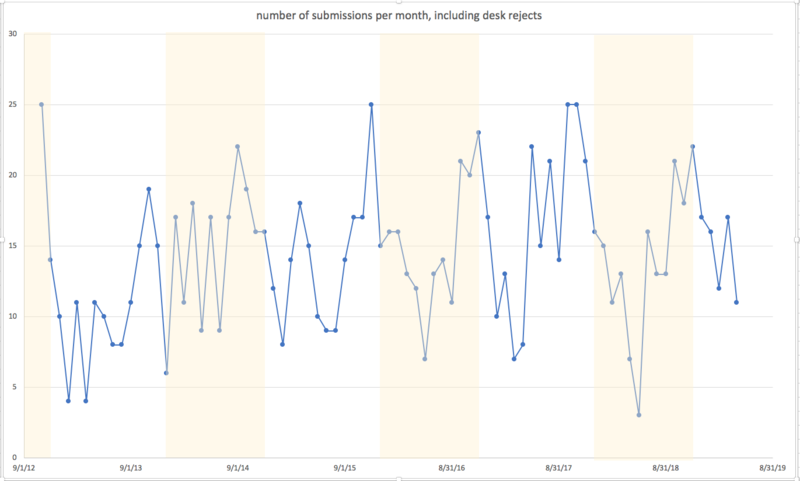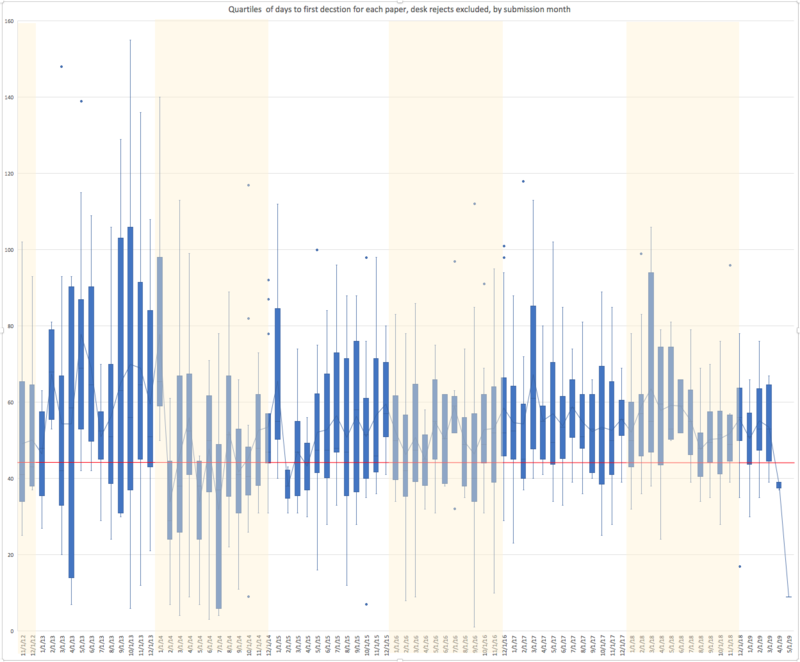2019Q1 Reports: TACL Journal
MIT Press transition
We are pleased to report that all TACL papers, past and present, are now available at the MIT Press website, with the first batch of MIT-Press-managed papers having been released in December 2018. This was a few months later than we had all planned, but here in May 2019, we have, we believe, smoothed out many of the wrinkles in the process of coordinating between two complex entities and in reworking our "legal" apparati (forms and policies regarding copyright, preprint posting, releases, etc.). We would like to especially thank Levi Rubeck of MIT Press for being so helpful and thoughtful throughout; his patience in working out the details with TACL are greatly appreciated. We also thank Matt Post and Arya McCarthy of the ACL Anthology for help in working out issues in transferring data from MIT Press to the Anthology.
Unfortunately, the planned integration with Overleaf on the MIT Press side did not happen.
MIT Press will also be handling the application of TACL to be indexed by the major services. During the period covered by this report, we have prepared most of the documentation required for this application. We are in the midst of completing the final piece, a publication ethics statement, which should certainly be done in the next two months, as a very generous upper bound.
Finding professional submission-system support
TACL is in the midst of discussions with various vendors regarding professional paid support of the submission system, currently a 2.x version of OJS with in-house modifications. (The publication system, handled by MIT Press, is disjoint.)
An issue is that the latest version of OJS 3.x is a poor fit with some of TACL’s workflow, but 2.x is deprecated. TACL will probably transition to professional paid support of a version of the current system upgraded to 2.4.8 during this calendar year. Upgrading to 3.x remains an option for future years.
Personnel updates
An ad hoc search committee (chaired by Jan Hajic) has organised a search for a new co-Editor-in-Chief (EiC) to replace Lillian Lee, who will be retiring from TACL in December 2019. A call for nominations has been issued, deadline May 27, 2019: https://www.aclweb.org/portal/content/call-nominations-tacl-co-editor-chief-summer-2019-summer-2022
We note that Mark Johnson’s co-EiC term ends in June 2020, at which point TACL will revert to having two co-EiCs. Brian Roark’s term ends June 2021.
TACL currently has roughly 50 Action Editors (AEs) and roughly 230 members of the elite standing reviewing pool, while maintaining minimum eligibility requirements of the equivalent of tenured experience in the field (AEs) or several years post-PhD in the field (standing reviewers). The AEs and standing reviewers have done a terrific job upholding TACL standards, although even with the increased size of these two groups, it is sometimes a challenge to balance reviewing assignments and our “one person, one paper” workload objective in the face of increased submissions and re-submissions. Our AEs and standing reviewers are listed at: https://transacl.org/ojs/index.php/tacl/about/editorialTeam .
Statistics
Number of submissions and days to first decision
Here is the number of first submissions per monthly submission round (=nearest first-of-the-month), including desk rejects (see caveats at the end of this paragraph). More details: this plot excludes first versions of papers that were not considered due to minor technical formatting problems, papers handled using START (the early days of TACL), and re-submissions.
Observations:
- The trendline (omitted) is very slightly upwards, which should perhaps be interpreted as stable. We expect the number of submissions to increase dramatically once TACL is indexed by the major services.
- The number of submissions tends to peak around early winter, perhaps as authors strive to submit in time for their papers to be accepted at ACL.
- The number of submissions tends to drop in early summer.
Now, here is the history, depicted in terms of quartiles, of the average time to first decision, excluding desk rejects, grouped by round (=nearest first-of-the-month). A blue line shows the average time for each submission month, and the red horizontal line shows our “goal” time of 45 days. Yellow shading indicates alternate calendar years. More details: The decision time for papers submitted for a given month is counted as starting from the first of that month. Most May-2019 papers, and about 11 March-2019 papers, have not yet been decided, so the shape of the right-hand side of the graph will change. Also not counted: papers handled using START (the early days of TACL) and papers archived for some technical or formatting problem.)
Observations:
- The average time to first decision continues to bounce between 50-60 days. The ideal timeline would be 45 days (a detailed breakdown of this ideal can be found at the "Reviewing Procedure" section of [1]. So we are running about a week or week and a half, on average, later than we would ideally like to be.
- It's worth pointing out that, for reviewers that complete their reviews, over the past 12 months, the average review-completion time is 24.4 days, where the TACL "contract" is 21 days. Many, many thanks to these wonderful reviewers!
- Time to first decision seems to spike in early spring. Anecdotal evidence suggests that one cause is Action Editor and reviewer commitments to conferences (or burnout from said commitments). Admittedly, another contributing factor could be that the spring semesters constitute very heavy teaching loads for one of the co-EiCs.
Distribution of decisions
We had 135 papers submitted from the May 2018 round through the present, inclusive, that received a first decision. Of these, 18 (13%) were desk-rejected. Of the 117 left, the decision breakdown was:
2% (a) = accepted as is 23% (b) = conditional accept: acceptance guaranteed if conditions met 58% (c) = rejected, encourage resubmission but no guarantee of acceptance 27% (d) = rejected with 1-year moratorium on TACL submission.
Of the additional 28 resubmissions of (c)s that were submitted during the same period and received a decision, and recalling that TACL policy is not to give two (c)s in a row, the breakdown was:
11% (a) 43% (b) 39% (d)
There was one special case that had to be handled differently.
Number of TACL papers presented at conferences
These counts are not broken down by talk vs. poster, but rather, group these categories together.
ACL 2019: 22 (3 conditional on AE technical approval of final version, to be submitted). NAACL 2019: 8 EMNLP 2018: 10 ACL 2018: 20 NAACL 2018: 16
It should be noted that some TACL authors do request poster presentation rather than a talk.
Publishing statistics
Volume 6 (2018) had 48 non-erratum papers and 0 errata. So far, volume 7 (2019) has 14 non-erratum papers and 0 errata, with 11 papers in the publication queue and 7 awaiting submission of the final version by the authors.

